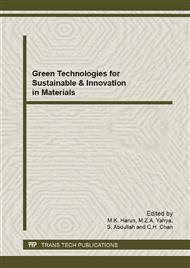[1]
L. T. Canham, Silicon quantum wire array fabrication by electrochemical and chemical dissolution of wafers, Applied Physics Letters, vol. 57, pp.1046-1048, (1990).
DOI: 10.1063/1.103561
Google Scholar
[2]
Y. Zhao, Z. Lv, Z. Li, X. Liang, J. Min, L. Wang, W. Shi, and Y. Liu, The relationship between hydrogen atoms and photoluminescent properties of porous silicon prepared by different etching time, Solid-State Electronics, vol. 54, pp.452-456, (2010).
DOI: 10.1016/j.sse.2010.01.022
Google Scholar
[3]
D. L. Yue Zhao, Wenbin Sang, Deren Yang, Minhua Jiang, The influence of microstructure on optical properties of porous silicon, Solid-State Electronics, vol. 51, p.678–682, (2007).
DOI: 10.1016/j.sse.2007.02.042
Google Scholar
[4]
K. Molnár, T. Mohácsy, P. Varga, É. Vázsonyi, and I. Bársony, Characterization of ITO/porous silicon LED structures, Journal of Luminescence, vol. 80, pp.91-97, (1998).
DOI: 10.1016/s0022-2313(98)00074-x
Google Scholar
[5]
F. P. Mathew and E. C. Alocilja, Porous silicon-based biosensor for pathogen detection, Biosensors and Bioelectronics, vol. 20, pp.1656-1661, (2005).
DOI: 10.1016/j.bios.2004.08.006
Google Scholar
[6]
M. Archer, M. Christophersen, and P. M. Fauchet, Electrical porous silicon chemical sensor for detection of organic solvents, Sensors and Actuators B: Chemical, vol. 106, pp.347-357, (2005).
DOI: 10.1016/j.snb.2004.08.016
Google Scholar
[7]
R. L. Smith and S. D. Collins, Porous silicon formation mechanisms, Journal of Applied Physics, vol. 71, pp. R1-R22, (1992).
DOI: 10.1063/1.350839
Google Scholar
[8]
P. G. Abramof, A. F. Beloto, A. Y. Ueta, and N. G. Ferreira, X-ray investigation of nanostructured stain-etched porous silicon, Journal of Applied Physics, vol. 99, (2006).
DOI: 10.1063/1.2162273
Google Scholar
[9]
H. Liu and Z. L. Wang, Etching silicon wafer without hydrofluoric acid, Applied Physics Letters, vol. 87, pp.1-3, (2005).
DOI: 10.1063/1.2158021
Google Scholar
[10]
D.R. Turner, J. Electrochem. Soc, vol. 105, p.402, (1958).
Google Scholar
[11]
R. Herino, G. Bomchil, K. Barla, C. Bertrand, and J. L. Ginoux, Porosity and pore size distributions of porous silicon layers, Journal of the Electrochemical Society, vol. 134, pp.1994-2000, (1987).
DOI: 10.1149/1.2100805
Google Scholar
[12]
B. C. a. A. H. I Gregora, Appl Phys, vol. 75, p.3034, (1994).
Google Scholar
[13]
L. S. Y. Monin, B. Champagnon, C. Esnouf, A. Halimaout, Simultaneous microphotoluminescence and micro-Raman scatteringin porous silicon, Thin Solid Films vol. 255, pp.188-190, (1995).
DOI: 10.1016/0040-6090(94)05681-3
Google Scholar
[14]
M. K. J. Zuk, G.T. Andrews, H. Kiefte, M.J. Cluter, R. Goulding, N.H. Rich, E. Nossarzewska-Orlowska, Characterization of porous silicon by Raman scattering and photoluminescence, Thin Solid Films, vol. 297, pp.106-109, (1997).
DOI: 10.1016/s0040-6090(96)09532-6
Google Scholar
[15]
R. M. Mehra, V. Agarwal, V. K. Jain, and P. C. Mathur, Influence of anodisation time, current density and electrolyte concentration on the photoconductivity spectra of porous silicon, Thin Solid Films, vol. 315, pp.281-285, (1998).
DOI: 10.1016/s0040-6090(97)00756-6
Google Scholar
[16]
Y. Kumar, M. Herrera, F. Singh, S. F. Olive-Méndez, D. Kanjilal, S. Kumar, and V. Agarwal, Cathodoluminescence and photoluminescence of swift ion irradiation modified zinc oxide-porous silicon nanocomposite, Materials Science and Engineering: B.
DOI: 10.1016/j.mseb.2012.01.017
Google Scholar
[17]
N. A. Asli, S. F. M. Yusop, M. Rusop, and S. Abdullah, Surface and bulk structural properties of nanostructured porous silicon prepared by electrochemical etching at different etching time, Ionics, vol. 17, pp.653-657, (2011).
DOI: 10.1007/s11581-011-0543-5
Google Scholar
[18]
P. P. L. Z. Sui, I.P. Herman, G.S. Higashi, and H. Temkin, Raman analysis of light-emitting porous silicon, Applied Physics Letters, vol. 60, pp.2086-2088, (1992).
DOI: 10.1063/1.107097
Google Scholar
[19]
Z. P. W. H. Richter, and L. Ley, The one phonon Raman spectrum in microcrystalline silicon, Solid State Commun., vol. 39, pp.625-629, (1981).
DOI: 10.1016/0038-1098(81)90337-9
Google Scholar
[20]
P. P. V. Paillard, M.A. Laguna, R. Carles, B. Kohn, and F. Huisken, Improved one-phonon confinement model for an accurate size determination of silicon nanocrystals, Appl Phys, vol. 86, pp.1921-1924, (1999).
DOI: 10.1063/1.370988
Google Scholar
[21]
P. Moriarty, Nanostructured Materials, Reports on Progress in Physics, vol. 64, pp.297-381, (2001).
Google Scholar
[22]
K. J. A.K. Sood, and D.V.S. Muthu, Raman and high-pressure photoluminescence studies on porous silicon, Journal of Applied Physics, vol. 72, pp.4963-4965, (1992).
DOI: 10.1063/1.352066
Google Scholar
[23]
N. D. Z. Gaburro, and L. Pavesi, Porous silicon, Encyclopedia of Condensed Matter Physics, p.391–401, (2005).
DOI: 10.1016/b0-12-369401-9/01149-9
Google Scholar
[24]
K. A. Salman, K. Omar, and Z. Hassan, The effect of etching time of porous silicon on solar cell performance, Superlattices and Microstructures, vol. 50, pp.647-658, (2011).
DOI: 10.1016/j.spmi.2011.09.006
Google Scholar
[25]
Z. A. T. W. Y. Kasra Behzad, Azmi Zakaria, and a. E. S. Afarin Bahrami, Advances in Optical Technologies, vol. 5, pp.157-168, (2012).
Google Scholar
[26]
N. Y. Y.H. Ogata, R. Yasuda, T. Tsuboi, T. Sakka, and A. Otsuki, Structural change in p-type porous silicon by thermal annealing, Journal of Applied Physics, vol. 90, pp.6487-6249, (2001).
DOI: 10.1063/1.1416862
Google Scholar
[27]
Y. K. X. a. S. Adachi, Light-emitting porous silicon formed by photoetching in aqueous HF/KIO 3 solution, Journal of Physics D: Applied Physics, vol. 39, pp.4572-4577, (2006).
DOI: 10.1088/0022-3727/39/21/011
Google Scholar


